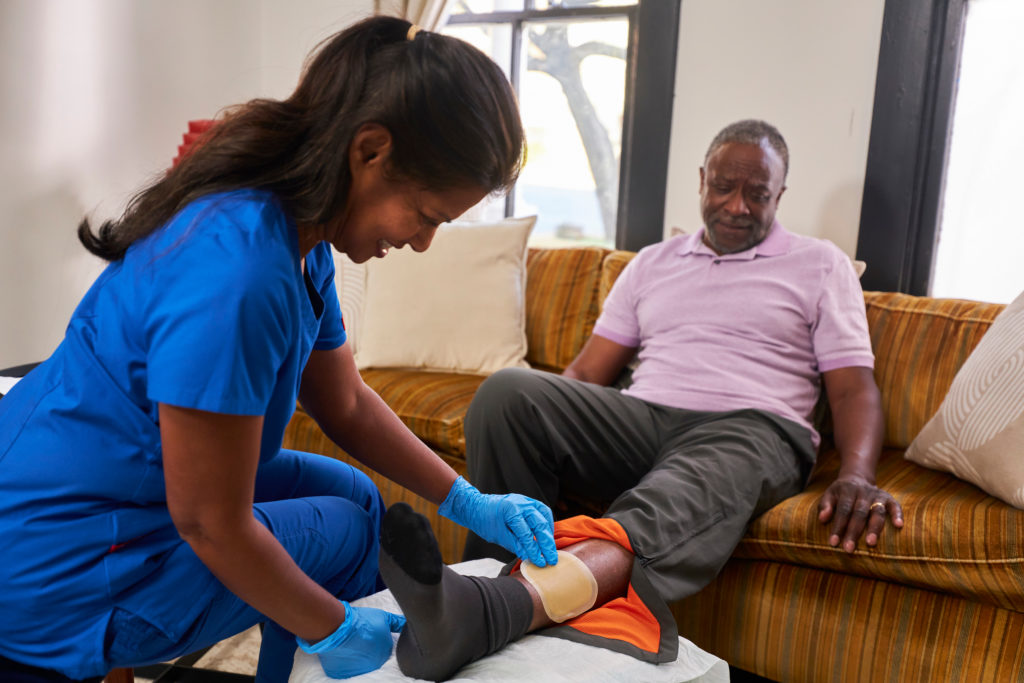
Whether it’s a scrape, stitches or surgical sites, any wound needs to be properly cared for to avoid infection, promote healing, and prevent scarring. There are many myths and misconceptions surrounding wound healing, though. Here are some of the most common questions asked regarding wound care.
Should I use hydrogen peroxide on my wound?
Hydrogen peroxide is an antiseptic used to disinfect, so it makes sense that it would be good for wound healing, right? Wrong. The only time hydrogen peroxide is beneficial is during the initial cleaning.
Studies show that higher concentrations will lead to inflammation and delayed wound healing. While it is very visually satisfying to see the bubbles when it meets your open cut or scrape, the hydrogen peroxide is causing damage to the skin around the wound and inhibiting healing.
The better option is to use mild soap and water or a special wound cleaner to flush out any trapped debris. Medical professionals suggest cleaning wounds using sterile isotonic saline or water warmed to your body temperature. Use a syringe to flush out waste, too.
How often should my wound be cleaned?
Unless directed otherwise, you should clean your wound daily with soap and water, rinse well, and then pat it dry with a clean towel. You should also clean your wound any time you can visually see that it is dirty.
Should I keep my wound covered or let it breathe?
Small cuts or scrapes can be left uncovered, but wounds heal faster if they remain moist. A dry wound will increase pain and slow the healing process. Moisture helps keep the skin cells around the wound alive, regenerate blood vessels more quickly, and protect the wound from the elements, germs, and further injury.
What ointment works best for healing wounds?
Antibiotic ointments like Neosporin are the standard choice for most consumers. The American Academy of Dermatology (AAD) recommends Neosporin for infected wounds. If your injury is not infected, the AAD recommends good ole’ petroleum jelly (name brand: Vaseline) to keep your wound moist and prevent too much scarring.
Clean your wound every day, apply petroleum jelly, and then, an adhesive bandage for at least the first five days.
Studies have shown that petroleum jelly is equally, if not more, effective than many antibiotic ointments. For wounds that are open, stalled, or infected, try using Iodosorb Antimicrobial Gel.
How do the elements (sun, water, heat/cold, etc.) affect wound healing?
Doctors recommend that you protect healing wounds from sunlight. Sun exposure will cause the wound to dry out and heal more slowly while making any scarring darker. Even after the wound heals, cover scars with sunscreen to prevent them from becoming more noticeable.
Cold temperatures slow our blood flow and redirect circulation to our major organs, meaning your wound is not receiving the nutrients and oxygen it needs to repair itself or fight off infection. The Journal of Wound Care explains that the cells of our body repair themselves best when at average body temperature (32° C/98.6° F). Even a 2° C drop in temperature can cause all healing to stop. On the other hand, heat can help bring more blood to the wounded area, speeding up healing.
As for water, while the wound should be kept moist, too much water will only serve to breed infection. Avoid submerging or soaking your wound in a swimming pool, ocean, or bathtub. Showering is acceptable, but wait at least 24-48 hours if you have stitches or staples. Be sure to follow the doctor’s orders when it comes to showering or bathing after an injury or surgery.
Are there any home remedies that have potential healing properties?
Due to the increased use of antibiotics and the subsequent increase in resistant bacteria, you may want to consider alternative ointments to help your wound heal. Researchers are divided on the healing properties of aloe vera. At the same time, honey has consistently shown to be an excellent way to keep wounds (including burns) moist under bandages, sometimes healing wounds in half as much time.
Studies support alternative or homeopathic methods to promote wound healing, such as arnica Montana (mountain daisy) and calendula (marigold plant).
Researchers have found that some vitamins and nutrients in food or as supplements work to promote healing include arginine, glutamine, vitamins A, C, and E, magnesium, and zinc. They provide essential elements to help your skin rebuild.
The Bottom Line
The most critical factors in speeding up the wound healing process include keeping the wound clean, moist, and covered. Avoiding exposure to harsh chemicals and the elements will not only help your injury to heal, but it will reduce scarring, too.
Always be sure to follow your doctor’s directions for wound care, as they may differ depending on your situation. Wounds take time to heal, but if you treat them with care, they can recover much faster.

